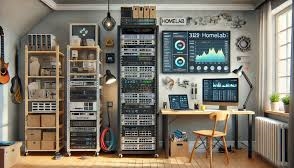These days, building your own home server means establishing a digital fortress that keeps your most treasured memories safe, streams your media without a hitch, and runs cutting-edge AI technologies with incredible speed and flexibility. Setting up a robust home server is a good idea for the future because technology is moving toward decentralization and giving people authority over their own data.
Begin by choosing the right hardware. You need a CPU with at least four cores, either as AMD Ryzen 3000 series or newer, or an Intel CPU that works with Quick Sync. This will make it easier to transcode videos in the future. A boot disk with an NVMe SSD that has at least 512GB starts up and responds promptly. Mirrored or RAID-Z hard drives secure your data from drive failures and keep your large storage safe by always having a backup. A dedicated Nvidia GPU with hardware transcoding can speed up tasks that involve a lot of media or AI by a lot.
Virtualization is what makes this digital ecology possible. Platforms like **Proxmox VE** offer very flexible environments that can run both full virtual machines and lightweight containers. You can split services, from media servers like Jellyfin or Plex to AI apps, because of this flexibility. By pinning CPU cores and setting exact resource limits, you may improve resource allocation and security and keep things from slowing down.
Keeping your data protected is very important. If you use **ZFS storage pools** with RAID-Z setups, your data will be safe at the enterprise level. This means that even if your hardware fails, your important media and backups will still be safe. A very strong safety net is made up of regular snapshots and automatic backups. Adding SSD caching makes it much faster to get to the files you use the most. This is a terrific method to get both speed and dependability.
You also need to organize your networking carefully. It’s far safer to use VLANs to split up your home network and Proxmox’s built-in firewall to keep it safe. You can also access your content on any of your devices, from smart TVs to smartphones, using Samba shares. Limits based on IP add another level of security that keeps privacy safe without making things less convenient.
Adding AI to your home server turns it into a smart brain that can run light machine learning models and AI-driven automation. A group of AI bots can accomplish things like smart support, tagging media for each user, and predicting how people will act. This makes your home setup an intelligent system that can change on its own and doesn’t need to use cloud services.
Here’s a pretty simple plan to get you going:
a. **Choosing Hardware**: Pick a CPU with at least four cores (Ryzen 3000+ or Intel with Quick Sync), an NVMe SSD boot drive with at least 512GB of space, RAID-Z or mirrored HDD arrays for bulk storage, and an optional Nvidia GPU to speed up media transcoding.
b. **OS & Virtualization**: To get the most out of Proxmox VE, turn on BIOS virtualization support, change the repositories and updates, and set up CPU pinning and RAM allocation for each VM/container.
c. **Storage Configuration**: Build ZFS pools in RAID-Z to keep your data safe. If you can, turn on SSD caching. For ultimate piece of mind, set up scheduled snapshots and automatic backups that are kept off-site or on multiple disks.
d. **Deployment of Containers and VMs**: Use lightweight Linux containers to run apps like Plex, Jellyfin, and AI services. Set smart resource restrictions so that everything works well even when there is a lot of traffic.
e. **Setting Up the Network**: Set up VLANs to segregate the network, turn on Proxmox firewall rules, and set up Samba shares with IP filters and authenticated users to make sure that multiple devices may safely and smoothly access media.
f. **AI Integration:** Use distinct containers for AI workloads, use GPU acceleration for tasks that need a lot of power, and look at local AI technologies for smart media management, voice control, and smart home automation.
In the future, a home server will be more than just a location to keep things. It’s a powerful machine that changes all the time and gives you more control, privacy, and tech comfort than ever before by leveraging modern virtualization, AI, and following best security practices. Your digital future isn’t “out there” somewhere; it’s right here in your home network, where everything fits and functions perfectly.






